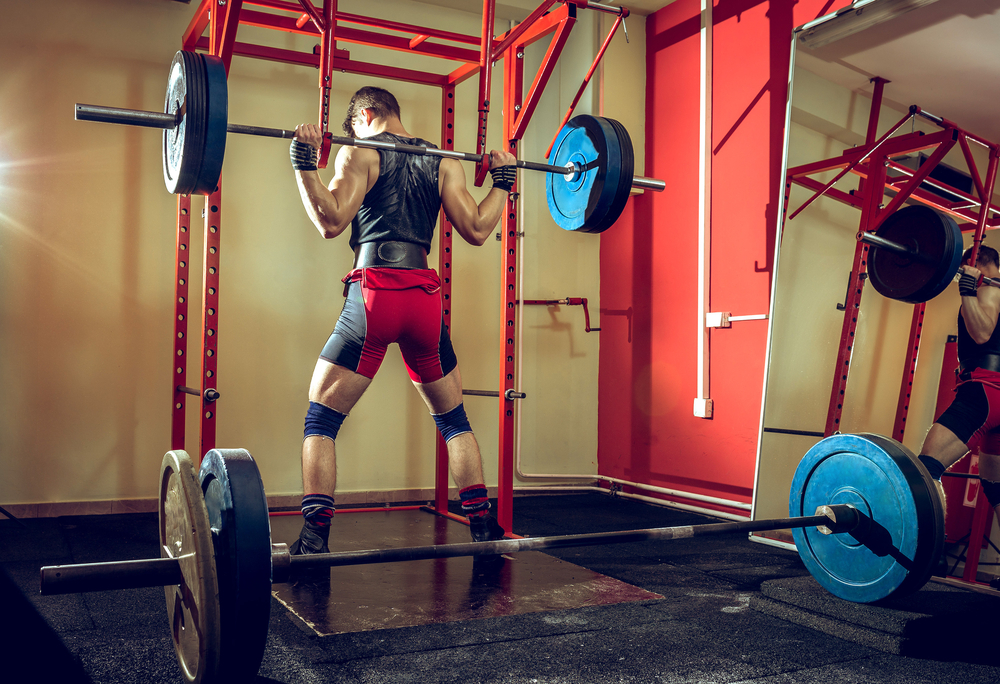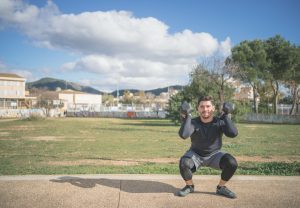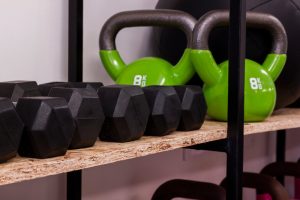Heavy squats are not effective for building hamstrings.
While they’re great for quads, glutes, and overall lower-body strength, research shows hamstring activation and growth remain minimal—keep reading to see exactly why that is and what to do instead.
Why Hamstring Activation During Squats Is Low
If you’ve assumed heavy squats automatically work your entire lower body evenly, it’s an easy misconception—but the reality is more nuanced.
While squats light up the quads and glutes, the hamstrings stay surprisingly quiet, even when the bar is loaded heavy.
Electromyography (EMG) data has repeatedly shown that hamstring activation during squats is relatively low compared to other major lower-body muscles.
This isn’t a one-off finding.
Across multiple studies, researchers have consistently observed that the hamstrings contribute far less than the quads and glutes, regardless of how deep you squat or how much weight you load.
For example, one systematic review compared muscle activity across various exercises and found that hamstring activation during squats was so minimal that seated hamstring curls produced nearly three times the EMG signal.
That kind of gap can’t be ignored if your goal is hamstring hypertrophy or targeted development.
Real-world testing backs this up.
A study using EMG shorts—sensors embedded in compression gear that measure muscle engagement during actual lifts—confirmed that free-weight squats lead to much higher quadriceps activity than hamstring activation.
Even under conditions that usually enhance total body recruitment, the hamstrings just don’t show up as prime movers.
This doesn’t mean squats are a poor exercise overall.
It means they simply aren’t built to challenge the hamstrings directly.
If you’re relying on squats alone for hamstring growth, you're leaving a lot of potential progress untapped.
Understanding this gap helps you train more effectively—and fix it with exercises that target the hamstrings in the way they’re actually designed to work.
Load, Depth, and Mechanics: Why Squats Still Don’t Hit Hamstrings Hard
It’s tempting to think that loading up the bar or squatting deeper will automatically force the hamstrings to work harder—but that only holds true to a limited extent.
The mechanics of the squat, combined with the anatomical function of the hamstrings, simply don’t allow for significant activation, no matter how intense the effort.
Increasing squat intensity to 90–100% of your one-rep max does cause a slight uptick in hamstring activity, particularly in the biceps femoris.
However, even at these high intensities, the engagement still falls well short of what’s seen in exercises designed specifically for hamstring activation.
In practice, the hamstrings remain in a supporting role, rather than acting as prime movers.
Depth changes the movement slightly, and deeper squats can trigger marginally more hamstring involvement.
But this effect is concentrated near the top of the lift, not throughout the full range.
So even though full-depth squats have many benefits for quads and glutes, they don’t significantly alter how much the hamstrings contribute overall.
The core reason lies in anatomy.
The hamstrings are biarticular muscles, meaning they cross both the hip and knee joints.
In a squat, the hip is flexed while the knee is also flexed.
This dual flexion puts the hamstrings in a mechanically disadvantaged position—neither fully stretched nor ideally shortened—making it hard for them to generate strong contractions.
This limited range for force production is a key reason why squats just don’t recruit the hamstrings the way other movements do.
And even if the hamstrings did contract more forcefully, they’d interfere with the lift.
Strong hamstring engagement would create unwanted knee flexion—exactly the opposite of what you need during the ascent phase of a squat, where extending the knees is the goal.
In other words, if the hamstrings fired hard, they’d be fighting against the very motion you're trying to perform.
So while tweaks in load and depth might move the needle slightly, they don’t change the fundamentals.
Squats are simply not biomechanically structured to train hamstrings effectively.
Understanding this limitation lets you program more intelligently—focusing squats on what they do well, and bringing in the right tools to train what they don’t.
What Squats Are Actually Good For
While squats may fall short when it comes to hamstring development, that doesn’t make them a poor exercise—far from it.
They’re still one of the most effective tools for building strength and size in other major lower-body muscles and should absolutely remain a core part of most training programs.
What squats do best is target the quadriceps.
The knee-dominant nature of the movement places heavy demand on the quads throughout the entire range, especially when performed deep and with challenging loads.
This makes squats ideal for quad hypertrophy and strength.
Glutes also benefit significantly, particularly in deep squats and when the hips are loaded through a full range of motion.
As the hips extend during the ascent, the glutes take on a major role, making squats a compound lift that delivers solid glute development over time.
The adductors—often overlooked—are heavily involved too.
In deep squats, especially those with a wider stance, the adductors contribute to both hip extension and stabilization, receiving a surprising hypertrophy stimulus.
Many lifters find that squatting consistently improves adductor strength without needing to isolate those muscles directly.
Outside of specific muscles, squats are excellent for developing general lower-body strength.
They engage the entire kinetic chain, including core and upper back stabilizers, especially in barbell variations.
This makes them highly functional for both athletic performance and everyday strength demands.
From a systemic perspective, squats also support hormonal responses that aid in muscle growth and recovery.
Heavy, compound movements like squats trigger greater release of growth-promoting hormones compared to isolation lifts—another reason they remain a staple in strength and hypertrophy programs.
It’s worth pointing out, however, that the hamstrings mainly act as stabilizers during squats.
They help control movement and support joint integrity, but they aren’t the drivers of the lift.
That role is dominated by the quads and glutes.
So if your goal is to grow hamstrings specifically, squats won’t take you far on their own—but they will build the foundation around them.
Understanding what squats actually do well helps you train with intent.
Instead of expecting one lift to do everything, you can use squats for what they’re built to deliver—and pair them with other movements that fill in the gaps.
What the Science Says About Hamstring Hypertrophy from Squats

Even if squats activate the hamstrings slightly, the bigger question is whether that activation actually leads to meaningful muscle growth.
Research across both short- and long-term studies gives a clear answer: squats alone don't significantly grow your hamstrings.
Long-term resistance training programs that rely on squats as the primary lower-body movement show consistent hypertrophy in the quadriceps, glutes, and adductors.
However, when researchers specifically measure the hamstrings—particularly the biceps femoris—they typically find little to no increase in muscle thickness or volume over time.
This holds true even in experienced lifters and well-structured training programs.
In shorter-term studies, where muscle thickness is measured after just a few weeks of squat-only training, the results are similar.
The biceps femoris tends to show minimal to no growth.
One acute study reported a slight temporary increase in muscle thickness when squats were paired with pre-stretching protocols, but this effect was short-lived and not associated with long-term hypertrophy.
It was more of an optical illusion—short-term muscle swelling rather than real structural change.
The takeaway is that measurable hamstring growth doesn't seem to follow from doing more or heavier squats.
That’s because the type of muscle stimulus needed to drive hypertrophy—sustained tension under meaningful load at an effective length—is simply not present for the hamstrings during squats.
On the other hand, research consistently shows that targeted hamstring movements do result in significant hypertrophy.
Exercises that involve either loaded hip extension (like Romanian deadlifts) or knee flexion (like leg curls) create much better conditions for muscle growth: they stretch the hamstrings under tension, allow them to contract forcefully, and often load them in ranges squats never reach.
If hamstring development is a priority, relying on squats as your main tool won’t get you there.
The data makes it clear—you’ll need to program direct hamstring work into your routine to see real progress.
Squats may build strength and support stability, but when it comes to muscle size, specificity matters.
Building Bigger Hamstrings: Exercises That Actually Work
If you want your hamstrings to grow, you need to train them in ways that actually load them through a full range of motion.
Unlike squats, which place hamstrings in a disadvantaged position, direct exercises challenge the muscle in its primary roles—hip extension and knee flexion—allowing for real strength and size gains.
The most effective movements fall into two categories: hip-hinge exercises, which work the hamstrings as they extend the hips, and knee-flexion exercises, which target the hamstrings' role in bending the knee.
Both are important for full development, and together they provide the kind of targeted stimulus that leads to hypertrophy.
Romanian deadlifts are a cornerstone for hamstring training.
They load the hamstrings in a stretched position, encourage a strong hip hinge, and maintain constant tension through the eccentric phase—ideal for growth.
Stiff-legged deadlifts provide a similar benefit but with a slightly greater stretch and less knee bend, increasing the demand on the hamstrings further down their length.
Good mornings follow a similar hip-hinge pattern but with the load placed on the upper back.
They reinforce posterior chain strength while stretching the hamstrings under load, making them especially valuable for both muscle growth and functional carryover.
Knee-flexion-based exercises, like Nordic ham curls and machine leg curls, hit the hamstrings from another angle.
Nordic curls in particular are brutally effective—they create high muscle tension through both concentric and eccentric phases and require minimal equipment.
Seated and lying leg curls are easier to progress and isolate the hamstrings more consistently, making them useful for hypertrophy-specific programming.
What makes these exercises work is the combination of mechanical tension and full-length contraction.
The hamstrings are placed under load while lengthened, moved through a complete range of motion, and allowed to contract without being compromised by other joint positions—as happens during squats.
To make these gains stick, consistency matters.
Plan one to two dedicated hamstring sessions per week, ideally balanced between hip-hinge and knee-flexion work.
You don’t need endless variation—just progressive overload, proper form, and focused effort.
Over time, this targeted approach will deliver growth that squats alone can’t match.
Smart Programming: How to Combine Squats with Direct Hamstring Work
Once you understand that squats aren't enough for serious hamstring development, the next step is to structure your training so both your front and back sides are properly trained.
This doesn't mean overhauling your entire routine—it means balancing it intelligently.
Start by keeping squats as a foundation.
Squatting two to three times per week gives you consistent stimulus for your quads, glutes, and overall lower-body strength.
Stick with free-weight barbell squats over machines like Smith machines or hack squats.
While the difference in hamstring involvement isn’t huge, free weights do encourage slightly more posterior chain activation and overall stability work.
When programming squats, aim for depth.
Deep squats are better for glute and adductor engagement, and while they only slightly increase hamstring activity—mostly at the top of the lift—it’s still worthwhile for overall movement quality and joint health.
Just don’t mistake this small activation bump as a substitute for direct work.
To fill the hamstring gap, add one to two focused hamstring sessions each week.
You don’t need to go overboard—just match the general intensity and volume of your squat work.
For example, if your squat sessions include 4–5 working sets of compound lifts, your hamstring work should mirror that with Romanian deadlifts, Nordic curls, or leg curls.
Keep the loading challenging but safe, especially for eccentric-focused exercises like Nordics or stiff-legged deadlifts, which can induce high muscle soreness if progressed too fast.
Think of your hamstring training as complementary, not competitive.
It doesn’t replace squats—it supports them.
Strong hamstrings reduce injury risk, improve hip stability, and even contribute to stronger lockouts in deadlifts and more powerful sprints and jumps.
Over time, this layered approach gives you a more complete lower-body program—one that covers all major muscle groups, avoids imbalances, and maximizes both performance and aesthetics.
Conclusion
Heavy squats are great for building strength and size in the quads, glutes, and adductors—but not the hamstrings.
Research consistently shows that hamstring activation and growth from squats alone is minimal.
To build bigger, stronger hamstrings, you need to pair squats with direct, targeted hamstring exercises.







